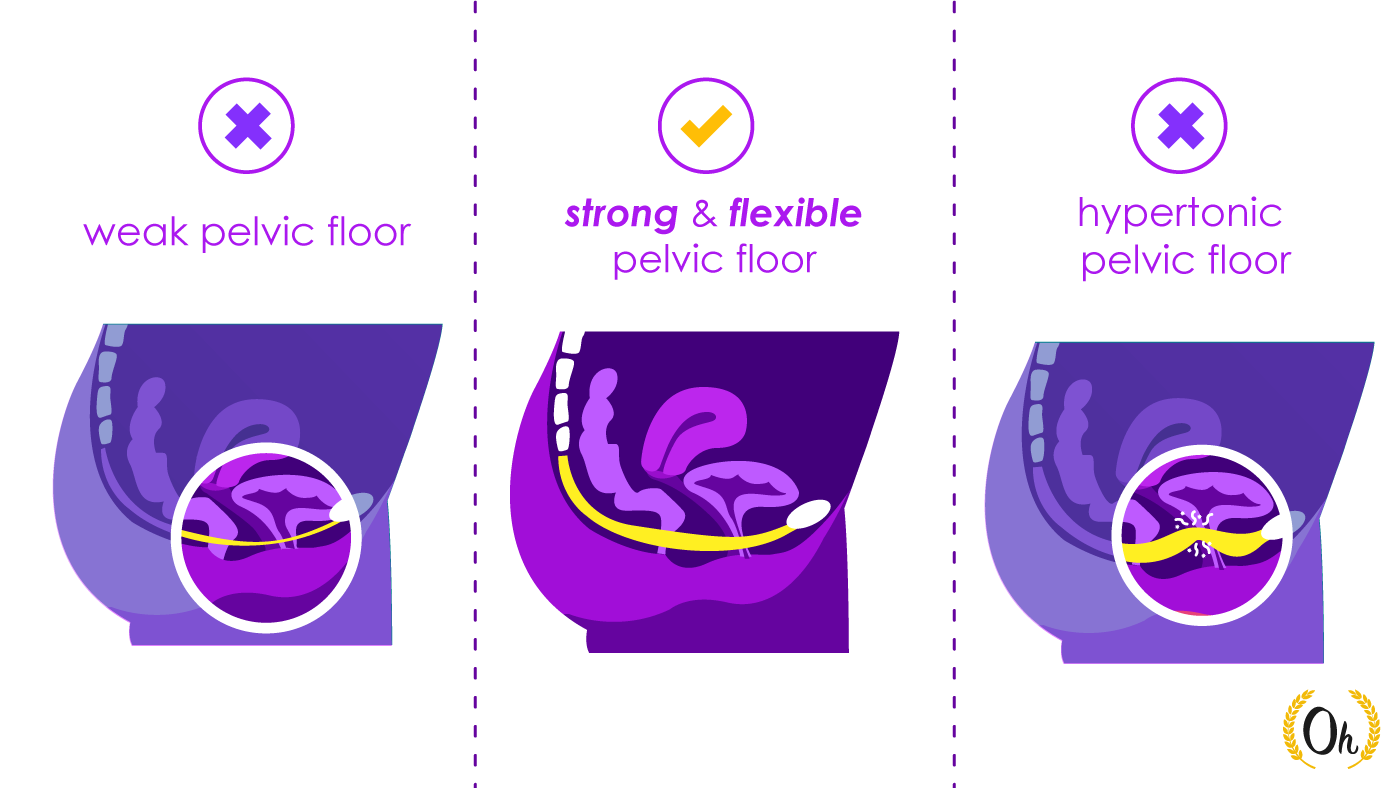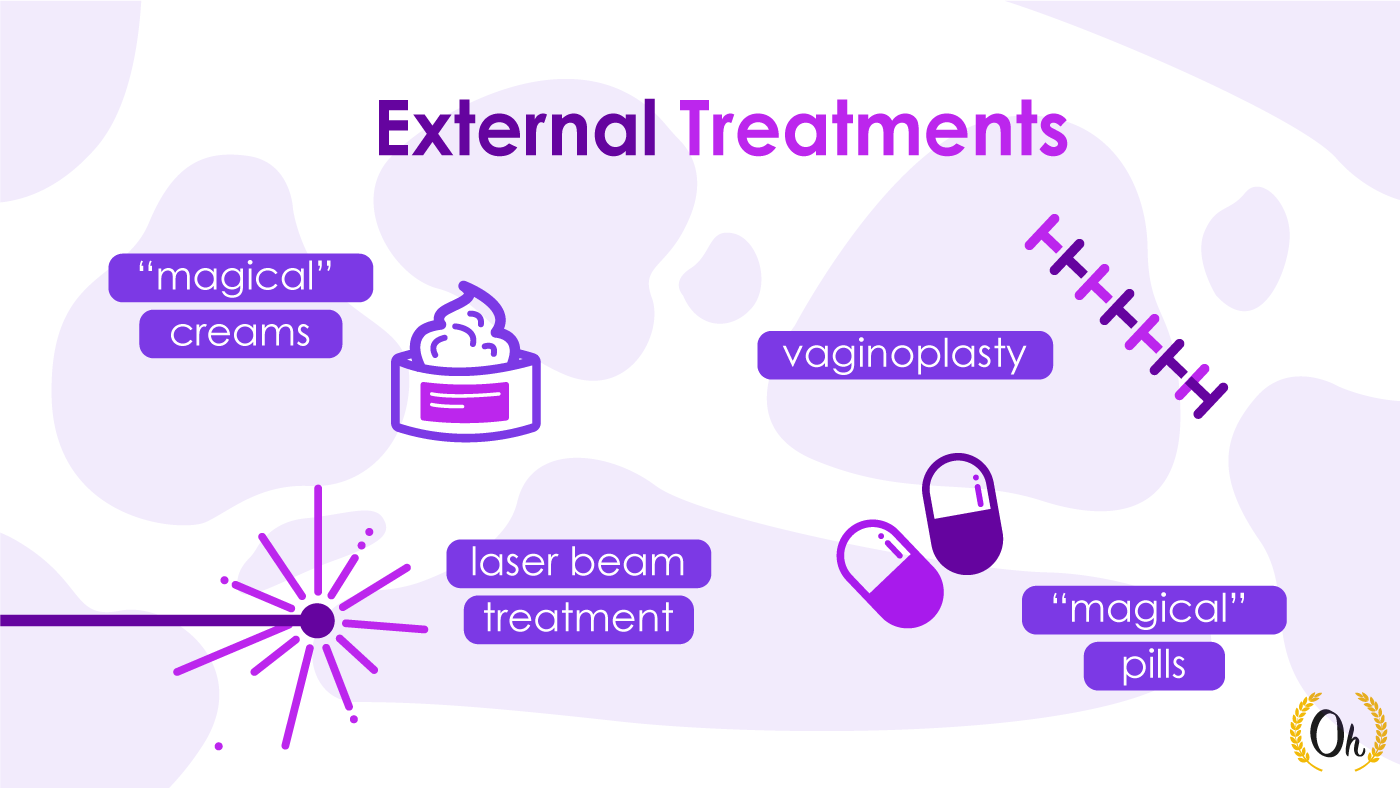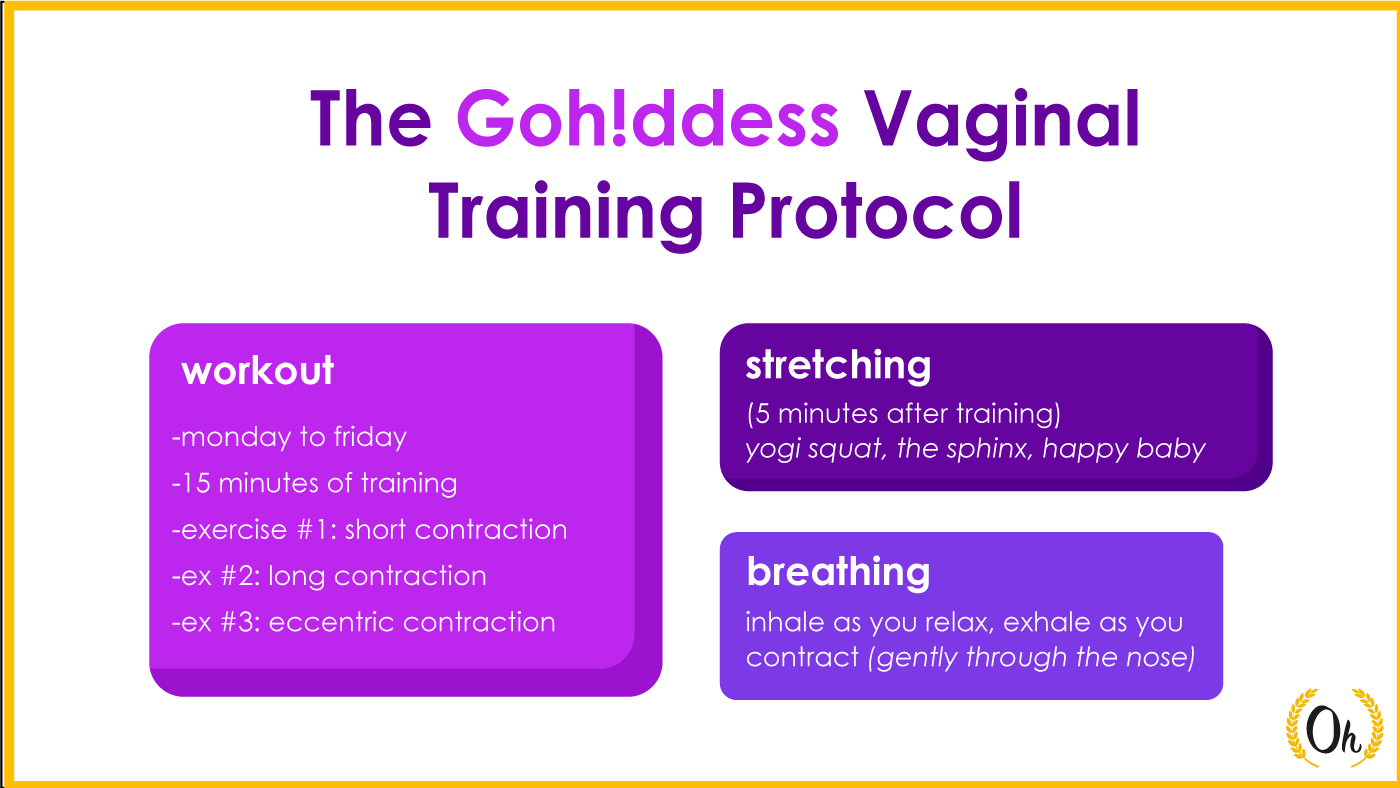
How to Tighten Your Vagina: The Science-Backed Guide
May 19, 2022I’d like to start this article off by addressing the two goals I’ve set for it.
The first goal is to create the most informational, science-backed guide on this topic. There are a LOT of online searches for phrases like “vaginal tightening”, and “how to tighten my vagina”, and simply put, I believe the current results are doing women a disservice.
Whether they’re lacking in scientific research or straight out lying to get you to buy their latest, seemingly magical product, there don't seem to be many articles addressing the topic in a holistic manner.
Hopefully I can achieve that here.
And second, I strongly believe, and I hope you will too by the end of this article, that there are some extremely beneficial reasons why you might want to consider strengthening (read: not “tightening” - and there’s an important distinction here) your lady bits.
Here’s the thing: I believe in everyone’s bodily autonomy, and their right to change something they want to change within their bodies.
But the reason why you’re doing it is equally important. It’s no news that for decades women have been put under extreme pressure to look a certain way, so I’m not even going to go there.
As we all know by now, doing something because someone else wants you to do it is not only psychologically damaging - in most cases, it's straight out ineffective.
This article is going to cover some real, science-backed reasons why you might want to pay special attention to this area of your body, just for you.
Spoiler alert: they're related to YOUR health & YOUR pleasure.
Here’s what I’ll be covering in this guide:
-the anatomy of the vagina, and why the term “tight” is, amongst many things, inaccurate
-common concerns like “can I tighten my vagina after giving birth?” and “am I too old to tighten my vagina?
-the infamous methods of vaginal tightening surgery, vaginal tightening gels, and - I can’t believe I’m writing this - vaginal tightening pills
-the science behind the methods that actually get you feeling stronger, flexible, and, most importantly, experiencing much more pleasure during sex!
-a full routine you can take to reverse vaginal laxity in a natural, science-backed way
Index
- Can You Tighten the Vagina? Your Pelvic Floor Anatomy
- Why You Want A Strong & Elastic Vagina
- Vaginal Tightening Surgery & Other External Treatments
- The Holy Grail of Vaginal Tightening: Don't Spend a Dollar
- Pompoir: Going One Step Further with the Oh!lympus Program
Can You Tighten the Vagina? Understanding your Pelvic Floor Anatomy
First things first: to say that a vagina is “too tight” or “too loose” would be, amongst other things, inaccurate.
This is because the skin surrounding your vagina contains collagen and elastin - two proteins that allow for your vaginal canal to expand and then return to its natural form.
What does this mean?
It means that the number of sexual partners a woman has, or how well endowed her partners are have no bearings on how “tight” she is, because these proteins make the vaginal skin extremely elastic and able to “snap back” into shape.
Myth dispelled!
Now, there are two main factors that could impact the elasticity of the tissue surrounding the vaginal canal:
1 - childbirth
2 - aging
It's important to note that neither of these factors threaten the elasticity of the vaginal canal permanently.
And as you’ll soon find out, even if they did, a woman can still regain the feeling and all the benefits of “tightness” by focusing on another skin layer: muscle.
Let’s look at both of these factors in more detail.
Vaginal Laxity after Childbirth
Vaginal laxity refers to a vagina that has lost some of its elastic quality and therefore, its ability to return to its natural, narrower shape.
It’s a problem that many women struggle with, and one that few are willing to discuss.
This is an unfortunate reality, because the treatment for this can actually be quite simple.
Let’s dive a little deeper.
Does the vagina become ‘loose’ after giving birth?
Not exactly.
During labor, the tissue surrounding the vagina can stretch too much and cause micro-tears that can affect the vagina’s natural elasticity and ability to snap back into shape.
But this is hardly ever permanent. For many women, the tissues will repair on their own after 3 to 6 months.
However, if the problem persists, there are ways to speed the repair process.
Can I "tighten" my vagina after childbirth?
Absolutely. Keep in mind, the female body was designed for birthing a child.
Since the beginning of your pregnancy, you’ve been releasing hormones like Estrogen and Relaxin which increase blood flow and relax your ligaments so that your vaginal canal can safely expand for labor.
And even though medically your vagina might not go back to the same exact shape as it was pre-pregnancy, it can definitely go back to feeling the same – both for you and your partner.
Those small tearings that occured during labor? They'll only be noticeable by a doctor during a medical examination, and they shouldn't affect sexual pleasure with proper postnatal recovery.
Vaginal Laxity Due to Aging
Starting in our mid 20s, we lose about 1% of our collagen production every year. And when a woman hits menopause, she can lose an extra 30%.
When collagen drops, so does elastin. This means that the vaginal walls become less stretchy and lose their ability to return to their natural shape.
Additionally, a drop in collagen can mean the weakening of pelvic floor muscles, which can exacerbate the laxity problem and lead to greater issues such as incontinence.
Does that mean I’m too old to tighten my vagina?
Nope! Even if collagen and elastin levels drop, you can still build the muscles around your vaginal walls to prevent and reverse the effects of a weak pelvic floor, as well as the discomfort that may come with a less stretchy vagina.
I’ll be detailing how to do this step by step in the last section of this article.
Other Factors that Can Affect Vaginal ‘Tightness’
Other conditions such as obesity , chronic constipation, and health-related drops in estrogen can lead to the thinning of vaginal tissue, and the weakening of the pelvic floor muscles overall.
When pelvic floor muscles are weak, they can’t support the natural shape of not only the vaginal canal, but other organs such as the bladder, the rectum, and the uterus.
This again, can cause problems that are more severe than loss of sexual sensation, such as urinary and fecal incontinence, lower back pain, and even muscle spasms in the pelvis.
Okay.
So now we understand that the vagina, when healthy, has the ability to snap back into shape after intercourse, and even after childbirth.
And we understand that real, serious vaginal laxity is typically a symptom that something else is going on, which can impact other areas of our health.
And that no number of sexual partners should affect the vagina’s incredible elastic ability. So we can put this awful claim to rest, once and for all.
Now that we understand the reasons behind vaginal laxity, let’s discuss what a healthy vagina looks and feels like - and what we can do about it.
Why You Want a Strong & Elastic Vagina
As we explained in our pelvic floor health guide, despite what we might have been conditioned to believe, a “tight” vagina isn’t necessarily synonymous with a healthy vagina.
In fact, lots of people suffer from a hypertonic pelvic floor.
This means that their muscles down there are too tense, whether because they’ve overtrained them, or simply because they naturally clench them without even noticing.
A hypertonic pelvic floor, just like a weak pelvic floor, can lead to constipation, pelvic pain, and painful penetration.
So what gives?
Well, the Goldie Locks of sexual health lies in having a pelvic floor that’s not too tense or too weak.

In other words, we want a vagina that’s strong, but also, flexible.
Much nicer (and accurate) terms than “tight” and “loose”, am I right?
Awesome.
So this begs the question: besides the obvious health reasons like, I don’t know, avoiding pelvic pain, why would we want a strong and flexible vagina?
I’m glad you asked.
The reasons we like to mention the most here at Goh!ddess (and a recurring theme you’ll notice when scrolling through our articles) is female pleasure.
*cue Hallelujah chorus.*
Simply put, having strong and flexible vaginal muscles allows you to enjoy sex much, much more.
You can check out our Orgasm Contractions guide for more on this, but to sum it up:
- Stronger Orgasms: when women orgasm, our vaginal canal’s muscles squeeze and release in a series of exquisite, involuntary spasms. The stronger our pelvic floor muscles are, the stronger these natural contractions will be.
Which, as you may have guessed, quite literally means, stronger orgasms.
- Penetration Sensation: strengthening the muscles around your vaginal canal makes it feel more “compact” and wrap around whatever’s penetrating it more closely.
This intensified friction allows for deeper G-spot stimulation and an enhanced connection with your partner’s body. - Vaginal tenting: when we’re aroused, our cervix and uterus shift to allow for an “extra space” in our vaginal canal to fit a penis, a finger, or a brand new silicon-soft vibrator. This process is called vaginal tenting, and it works because of our vagina’s amazing ability to lubricate and expand.
As you can imagine, a tense pelvic floor and lack of arousal can hinder this process.
Vaginal Tightening Surgery & other External treatments
Note that through this section, I’ll continue to refer to these procedures as “tightening” procedures because this is how they’re commonly referred to, so as to not cause any confusion.
As I’ve hopefully made clear throughout this article, I believe everyone should be allowed to change whatever they want to change in their own bodies.
I do not subscribe to the idea that any attempt to change ourselves is imposed by society, and the way we rebel against it is by remaining stagnant.
After all, would we oppose a woman who wants to dye her hair? Or get breast implants? Or gain muscle?
Of course not.
The problem with this particular type of change is twofold:
- First, intention matters. In an ideal world, we change because we want to - not because someone else told us we should.
And in the case of “vaginal tightening”, for a long time, the main reason why this was even a topic of conversation was because it was attached to how desirable the woman was to the other party at hand.
The woman’s health was not part of the equation. Neither was her comfort. And much less, her pleasure.
I covered the very real (and exciting!) reasons why you might want to consider giving your lady bits some more love and attention in the previous section.
- Second, many of the methods & procedures women are undergoing to get these results are lacking in research and tied to a poorly regulated aesthetic medicine industry.
Now, it could be argued that the reason for this lack of research comes down to the relative novelty of openly discussing female desire. But I digress.
Let’s take a look at some of the common external methods for vaginal tightening.
Vaginal Tightening Surgery
While vaginoplasty is an umbrella term that can also include gender affirmation surgery, it is generally used with the intention of repairing or tightening the vaginal tissue after pregnancy or sexual trauma.
During the procedure, typically performed under local anesthesia, the tissue underneath the skin is tightened with strong stitches to reduce the size of the vaginal canal.
Risks involving this procedure include a negative reaction to anesthesia, scarring, pain, bleeding, and (though less common) nerve damage resulting in permanent loss of sensation.
Vaginal Tightening Gel or Creams
Vaginal tightening creams and gels claim to work through their natural astringent components, often coming from exotic regions and based on ancient wisdom.
As Coyle Institute points out, what most of these creams and gels actually do is dry out the mucosa inside the vagina, decreasing lubrication.
When you’re less wet, friction during sex is enhanced, but so is discomfort.
None of these potions actually changed your skin layers in any permanent way. At best, they made sex uncomfortable; at worst, they can cause microtears that leave your vagina vulnerable to infection.
Vaginal Tightening Pills
Vaginal tightening pills claim to work either through their natural, herbal ingredients, or through the use of Vitamin C and Hyaluronic acid to enhance collagen production.
As with many of these products, there are usually no medical research papers or field experts backing these claims, so they rely on anecdotal, “legend has it”-stories as part of their advertising.
If there was a way to permanently and safely increase collagen and elastin production, believe me, you would not stop hearing about it.
And I promise you, L’Oréal & La Roche Posay would pay for the medical research first-hand.
Vaginal Tightening Laser
Vaginal tightening laser treatments, also called vaginal tightening wands or vaginal tightening sticks are advertised as modern, “alternative” approaches to the traditional vaginoplasty.
This treatment claims to be a non-invasive cure for vaginal dryness, vaginal inflammation, and loss of elasticity in the vagina.
During the procedure, a laser beam is inserted in the vagina to promote elastin fibers and collagen in the deep layers of the vaginal wall.
As of 2018, the FDA has stated that the safety and effectiveness of these devices hasn’t been evaluated or confirmed for “vaginal rejuvenation”, and that these types of procedures in general carry serious risks.
In February of 2022, Dr. Kristin E. Rojas conducted an informal review of the FDA’s Manufacturer and User Facility Device Experience (MAUDE) database for brand names of laser devices used for “vaginal rejuvenation.”
She found 41 adverse event reports over 10 years - one of them coming from a woman who after her treatment experienced bladder pain so bad she contemplated suicide.
Final Note on External Vaginal Tightening Methods
It is obvious that new devices and treatments for “vaginal rejuvenation” and “vaginal tightening” continue to appear because women continue to search for them.
And my goal with this article is not to scare you, but to provide you with a broader analysis that takes into account the views of professionals whose work is to evaluate these procedures.
The Society of Obstetricians and Gynecologists of Canada (SOGC) has outlined serious concerns about all of these external vaginal tightening methods in a study completed in 2020.
Researchers concluded that there is insufficient evidence to support any sort of female genital surgery to be effective for sexual satisfaction and/or self-image.
So while I’m no one to say that these methods don’t work, what I can tell you is that there’s not enough research to back them up yet. Especially when we look at mystical pills or creams.
Does this mean we’re doomed if we want to experience all the benefits that come with thicker vaginal walls?
Not even close.
Because the one science-backed way to naturally and safely make your vagina feel stronger, stretchier, and more sensitive is also another thing - absolutely free.
The Holy Grail of Vaginal Tightening: Don’t Spend a Dollar
What if I told you that you can prevent urinary incontinence, increase your libido, and enhance your orgasms without spending a dime?
You’d probably say I sound like a pyramid scheme enthusiast.
But it’s absolutely true.
See, what all of these pills and magic lasers and risky surgeries claim to do is enhance the production of collagen and elastin beneath the skin.
This in turn would help the vagina regain its elasticity and “snap back” into a more narrower shape.
And hey, if they worked - fantastic!
But sadly, evidence is not on their side.
What I propose you do is save your money and instead work on a deeper level of your skin: muscle.
Your pelvic floor muscles - and specifically, your pubococcygeus muscle - are in charge of holding your abdominal and pelvic organs.
When they’re too weak, your organs can fall down, and your vaginal, urinary, and fecal canals can start experiencing laxity.
This can lead to (you guessed it) urinary incontinence, fecal incontinence, and oh yes, loss of vaginal sensation.
And what can you do to prevent AND reverse all of these conditions? Easy.
Start training your vaginal muscles, love!

Pelvic Floor Muscle Training: The One true Vaginal Tightening Pill
If I’m going to talk about how these fancy pills and creams and laser beams have no scientific literature to back them, then I should probably provide the science behind pelvic floor training, right?
Feel free to skip to the next section if you want to go straight to the action, but for all of my fellow science nerds - check this out.
Starting with the less-exciting but certainly very important prevention of urinary incontinence, a 2014 systematic review of eleven trials involving 510 women showed that pelvic floor exercises significantly reduced the urinary incontinence symptoms of female stress urinary incontinence.
A similar review conducted in 2003 showed that pelvic floor exercises were just as effective at decreasing urinary incontinence in women postpartum.
This was also shown in a 2015 qualitative study of Taiwanese women undergoing pelvic floor muscle training. They reported not only an improvement in urinary incontinence symptoms, but also sexual enjoyment, body image, and self confidence.
Now we’re getting to the sexy stuff.
Before we dive right into pleasure, it’s worth noting that a weak pelvic floor can negatively impact other aspects of life as well.
In this 2009 study, 59 women with clinically proven stress incontinence were randomly put into either a pelvic floor exercise program or a control group.
After six months, the exercise group showed improvements not only in sex-life, but also social life and physical activity.
Alright - let’s get to the juicy stuff.
Starting with a 2013 research on pelvic floor training using electromyography, this study wanted to analyse the results of this type of exercise in a quantitative way.
Before that, the standard to clinically address female sexual function was through a qualitative questionnaire.
Spoiler alert - quantitative results were still incredible.
The pelvic floor training group showed a noticeable improvement in muscle strength in at least two types of muscle (pelvic floor muscles and abdominal muscles) compared to the control group.
As expected, the pelvic floor training group also showed sexual function improvements in the qualitative sexual function questionnaire compared to the control group.
Starting to see a trend here.
But how about specific sexual function measurements, like frequency of sex, libido, and orgasm satisfaction?
These results wouldn’t come until 2015, with two different studies.
One published in the International Urogynecology Journal where 585 women were surveyed and had a physical examination that determined their levels of pelvic floor strength and pelvic floor tone.
The results? There was a strong correlation between pelvic floor strength and rates of sexual activity. So much so that after multivariable analysis, a strong pelvic floor remained predictive of sexual activity.
Women with a strong pelvic floor continued to report higher sexual activity than women with a weak pelvic floor.
More frequent sex? Sign me up!
But wait - how about the quality of these encounters?
To answer this question, we’re going to travel all the way to Norway.
This same year, the Department of Sports Medicine in Oslo published another study where 50 women were randomly put into a pelvic floor training regimen, and 59 were put into a control group.
After six months of either training their lady bits or not, they were asked about their sexual function. And though in this specific case the frequency did not seem to vary between the groups, the quality sure did.
Women who underwent the pelvic floor exercise program reported increased control, feelings of a “tighter” vagina (their words!), strength and awareness of the pelvic floor, improved self confidence, resolution of pain during intercourse, heightened sexual gratification for their partners, and the kicker… higher libidos and better orgasms.

See, it’s not just me who says it… it’s science!
Alright, before we go straight into your pelvic floor muscle-building routine to get you feeling stronger, more flexible, and enjoying your sex life much more, I want to show you two more studies that address the question:
“Can I tighten my vagina after giving birth?”
In this 2013 study, 79 primiparous (read: women who gave birth) were randomly placed into two groups 8 weeks after giving birth. One group was put into a two month pelvic floor training regime, and the other was the control group.
After 8 weeks, pelvic floor strength significantly increased in the intervention group, and so did sexual self-efficacy.
No pills. No gels. No cosmetic surgery. Just a healthy dose of free exercise got these women feeling stronger and having better sex.
And these were women who had just given birth, too.
This is true if you’ve had multiple births as well.
In this 2019 systematic review of 12 studies on pelvic floor training (some including women who’d only given birth once, some including women who’d only given birth multiple times, and some including a combination of both groups) results showed that this type of training is a safe practice that boosts sexual function and quality of life.
There you have it - loads of evidence on the efficacy of pelvic floor training for making you feel stronger and sexier.
So next time you’re thinking of buying a magical V-wand that promises instant results, remember this:
If these companies had the science to back up these products, they sure as hell would be using them in their marketing.
Now let’s get to training, shall we?
Your Pelvic Floor Training Routine to Strengthen Your Vagina
I’m going to give you a simple routine that is going to get your muscles stronger in no time.
I won’t go into the science of muscle building in this guide, but know this: the same mechanisms that work to build your glutes, your abs, or your back muscles also work when building your pelvic floor muscles.
Because these are bodyweight movements, we’re going to be utilizing three different styles of training to induce muscle building: repetition, eccentric contractions, and time under tension.
Regimen
I want you to do this training Monday through Friday for just twenty minutes. Ideally, when you first wake up.
Fifteen of these twenty minutes will be exercising, and the five remaining minutes will involve some pelvic floor stretching.
Breathing
You’re going to align your breathing to the pelvic floor exercises. This is so that the pelvic diaphragm can follow the natural movement of the chest diaphragm.
When I ask you to contract, you’re going to gently breathe out your nose. And when I ask you to relax, you’re going to breathe in through your nose.
Don’t move your arms or head when breathing, don’t breathe through your mouth, and most importantly, don’t hold your breath.
When performing The Long Contraction, exhale when you first contract, and then allow your breath to naturally flow in and out as you hold.
Exercises
Perform these three exercises lying down on a yoga mat, with the soles of your feet on the floor and your knees bent.
The Short Contraction:
1- Inhale quietly through your nose
2 - As you exhale, lift your hips from the floor and simultaneously try to pull in with your vaginal muscles as if you were holding in your pee. Pull all the way in with all your strength.
3 - Lay down your hips as you relax your pelvic floor muscles and inhale again.
4 - Repeat this sequence 20 times.
The Long Contraction:
1- Inhale quietly through your nose
2 - As you exhale, lift your hips from the floor and simultaneously try to pull in with your vaginal muscles as if you were holding in your pee.
3 - This time around, continue breathing normally whilst holding the pelvic floor contraction and with your hips still in the air.
4 - Hold this position for 10 seconds, or as long as you can hold the pelvic floor pull for.
5 - When you can’t hold the pelvic floor contraction anymore, rest your hips back on the floor and relax your pelvic floor muscles.
6 - Rest for 10 seconds (or as long as you were able to hold the contraction for) and then start again.
7 - Repeat this sequence 10 times
As time goes by, you’ll be able to hold the contraction for longer. Focus on the strength of the pull rather than how long you can hold it for.
What matters most is that you’re truly holding with all your strength, rather than holding a weak contraction for a long time.
The Eccentric Contraction:
For this exercise, you’re not going to be lifting your hips in the air. I just want you to lay down and focus on your vaginal canal.
1- Inhale quietly through your nose
2 - As you exhale, pull in with your vaginal muscles as if you were holding in your pee. Pull all the way in, with all your strength.
3 - Instead of relaxing right away, I want you to inhale and slowly release the contraction. Focus on slowly letting go, and feeling each part of your vaginal canal as you do so.
4 - Repeat this sequence 20 times.
A trick to perform this exercise is by imagining that you’ve placed a marble at the entrance of the vagina, and you want to “show her around” the different levels of your vaginal canal.
It’s as if your vaginal canal was an elevator.
As you slowly pull in, you suck that imaginary marble inside of you, and you give her a tour of all the different levels of your canal, from the ground floor to the penthouse.
And then, as you release her back out, the marble slowly goes down the elevator, back to the ground floor.
Stretching
When you’ve finished with the three exercises, I want you to adopt the following positions for 5 minutes total to stretch out your pelvic floor and allow your muscles to relax.
Remember, we want to be strong AND flexible.
- Happy Baby: Lie down with your feet facing the ceiling as you hold the insides of your knees close to your chest. Keep your feet wider than shoulder width apart, and relax.
- The Sphinx: lay on your stomach and push down onto your forearms to lift your chest up. Keep your back arched and relax your body.
- Yogi squat: Squat all the way down until your knees are pointing to the ceiling. Keep your back straight and your arms inside your legs. Press your palms together and rest your elbows on the insides of your legs to keep your balance.
If you can’t do a Yogi Squat just yet, use a pillow under your butt to sit down as you stretch out your pelvic floor.

The Oh!lympus Program: Going One Step Further
So now you know. There’s no such thing as a “tight” or “loose” vagina, because your pelvic muscles have an incredible capacity for changing and growing.
And we don’t need to spend any money to make our most precious muscles grow.
If you do want to take this a step further, and find out how you can manipulate and control your vaginal muscles to create all sorts of pleasurable sensations for you and your partner (I’m talking squeezing, tilting, gripping, sucking, and even twisting!) then I invite you to join The Oh!lympus Program.
In this fully animated course, you’ll learn over 27 unique motions you can perform with your vaginal muscles, and take your sex life (and your partners’) to an entirely new level.
Have fun training, sex goddess!
Ready to become the ultimate sex goddess?
Get our step-by-step, fully animated Pompoir course.
Stay connected with news and updates!
We hate SPAM. We will never sell your information, for any reason.


